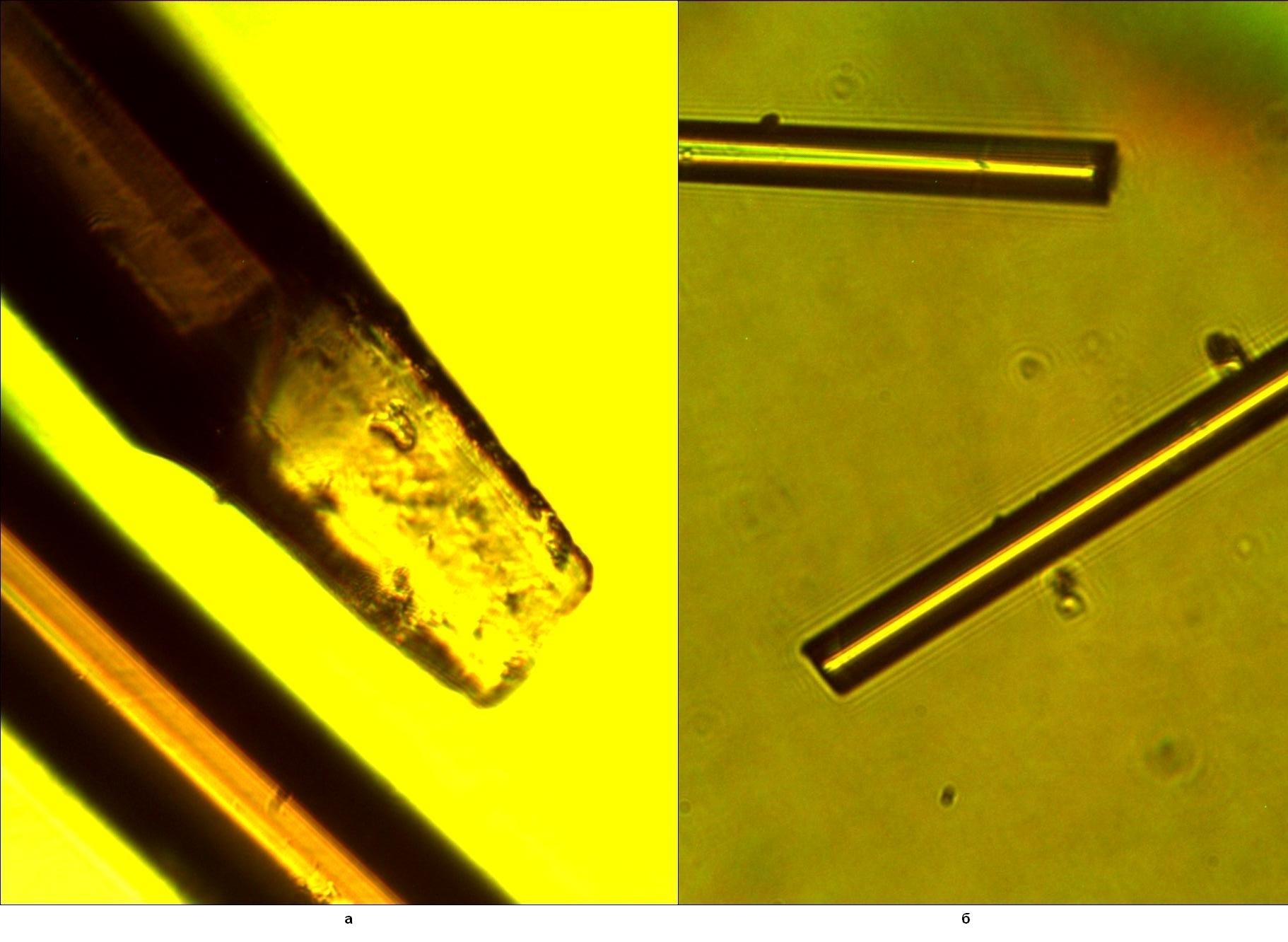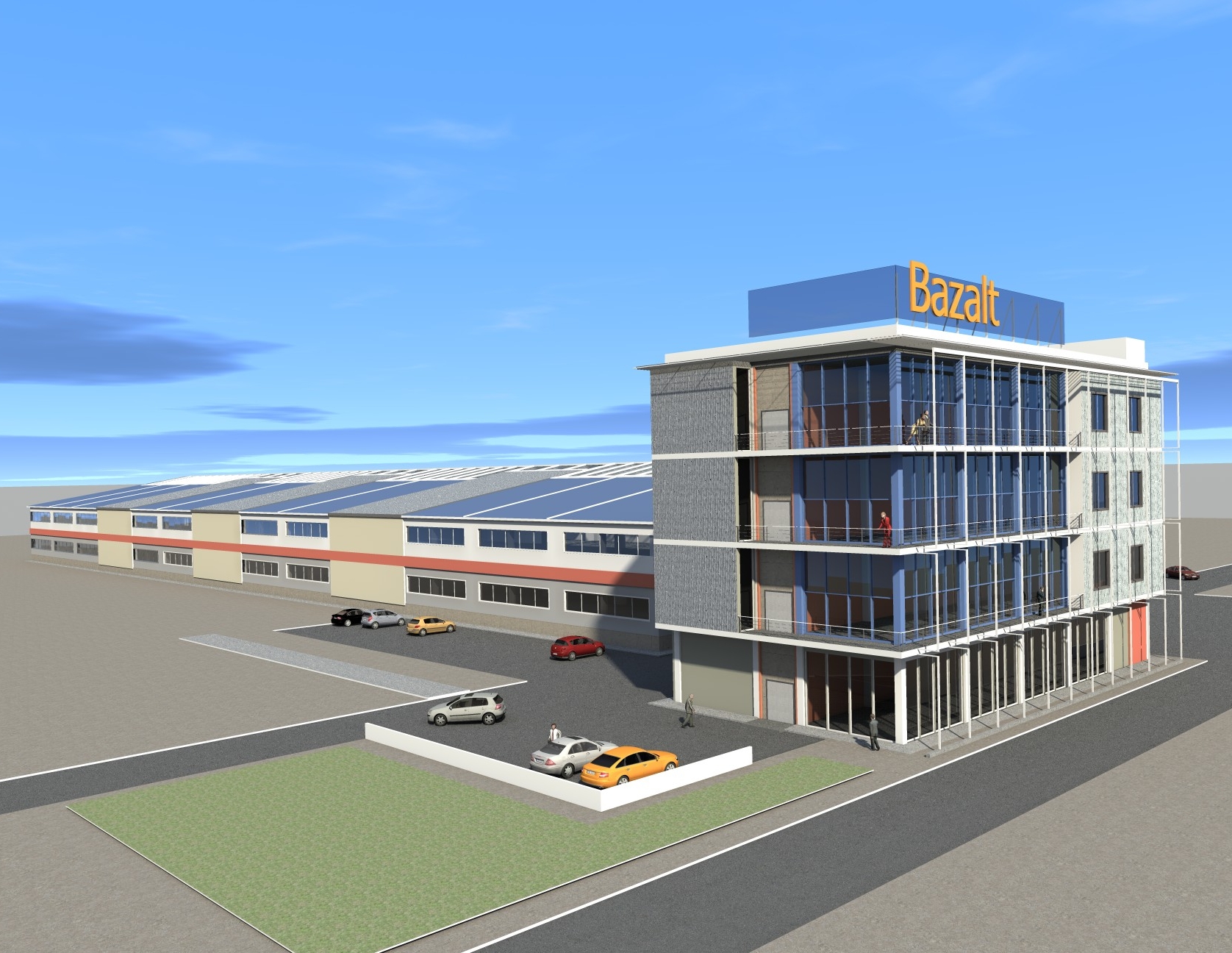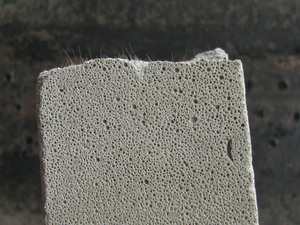 Dr.
Aleksandr
Novytskyi
Processing of rock
basalt types in
different types of
fiber, a personal
information site
Dr.
Aleksandr
Novytskyi
Processing of rock
basalt types in
different types of
fiber, a personal
information site
Dr. Alexander. Novyskyi, Dr. Mikhail Efremov
Mineral 7 JSC (Ukraine)
Some aspects of the technological process of continuous basalt fiber CBF
Production of continuous basalt fiber based on melting in the melting aggregate crushed basalt, followed by stretching of the resulting melt filaments. The formation of filaments through holes in the bushing. Thus, despite the variety of physical processes occurring in the formation of the fiber node, the determining factor is the process of melting of basalt to produce a melt.
The process of producing a basalt melt is usually regarded as a process of melting a heterogeneous system, which consists of several physically homogeneous silicate mineral compounds, which are represented in the form of crystal and glass. In general, the molten basalt is dark glass melt, in connection with which the processes of formation of basaltic melt can be applied theories and hypotheses of formation of the glass melt.
Thus, all the hypotheses tolerance of high polymer glass, aperiodic, but, nevertheless, is not devoid of certain ordered microdomains carcass. This structural frame formed by polyhedra as infinite anion radicals the adjustable window located in the force electric field modifier cations.
The hypothesis of the crystallite glass structure since its inception and to date has undergone some changes. The study of the structure of various glasses clearly reveals the micro heterogeneity of their structure. It follows that the actual glass composed of an ordered part of the crystallites and not ordered amorphous. Most scientists agree that the structure is amorphous crystallite glass
In order structure affect the melting temperature of the melt, the melt holding time at temperatures above the crystallization temperature, the presence in the composition of alkali metal cations, the effect of the electromagnetic field, the presence of strong Vandervalsovyh bonds. The presence of mineral memory allows to assume that in the glass structure, such connection is not strong as that of the crystalline body, it also confirms less chemical resistance of the glass as compared to samples of the same composition of the crystal structure.
Based on a study of the glass melt basalt produced in different temperature conditions, it was found that a decrease in the rate of cooling glass of its chemical resistance increased and decreased strength. When the temperature of the melt preparation obtained an inverse relationship. By increasing the dwell time of the melt at a certain temperature above the crystallization temperature dependence remains. Also a significant factor affecting the properties of the resulting glasses is the electromagnetic treatment of the melt, which allows users to secure the effect of the destruction of mineral memory and obtain high strength glass. An important factor when working with glass from rock is that the melt with no destruction of mineral memory may restore structural mineralogical composition of the crystalline body, when the cooling process is to conduct a low speed shutter and at certain temperatures. This suggests a partial confirmation of the crystallite hypothesis.
The process of forming the molten basalt occurs at temperatures ranging from 1720 to 1535K at a temperature upper limit of the crystallization region 1530K. Moreover these temperatures are different for different types of basalt raw material to be processed. In this regard, setting intervals temperature is one of the basic elements of a process control and preparation of the melt basalt continuous fiber with desired properties.
The process of forming fibers from the melt through a spinneret determined by the viscosity of glass and its character changes depending on the temperature, size of the upper limit of crystallization, its velocity, as well as surface tension. Basalt melts suitable for producing continuous fiber must be characterized by a low crystallization rate [6]. If the tendency to melt crystallization is large, the process must be conducted at a higher temperature than that which corresponds to the desired viscosity, which leads to additional technical problems. If the glass has a low crystallization rate, then it is possible to form fibers, and in the case when the temperature corresponds to the temperature crystallization production or even below it.
Processing of basalt glass should have a relatively wide range of output, i.e. the temperature range in which the technological properties of the glass, primarily the viscosity values are defined and can not be drastically altered. Basalt glass having a wide range of development, does not require careful control of the temperature, and the process of developing more stable. For a stable process is necessary that the difference between the final and initial temperatures generation was about 100K.
Impact on the glass-forming components of high temperatures leads to their modification, creation of new links and the formation of the glass structure. These factors greatly affect the characteristics of the melt. Changing Melting range, the holding time of the melt in the environment of high temperature and the cooling of the melt in the process of producing continuous fiber can effectively control the quality of the final product.
Also managed the temperature effects on raw materials important factor in producing high quality fiber is also the choice of the raw materials. Its chemical composition determines the temperature conditions obtaining the melt, its characteristics and ultimately the quality of the manufactured products. [7]
As noted above, based on production of continuous basalt fiber technology incorporated mechanical drawing filaments from the melt. This technology is currently being implemented in two ways, which differ only in the hardware design process. The first method determines the use of small furnace units modular (modular technology) with the possibility of establishing in the furnace unit of one, two slotted bushings or plates. The second method determines the use of a lot bushmng (many bushing technology) furnace units with installation of jet and bushing in an amount of from 6 to 12 pieces. The main producers of basalt continuous fibers develop their production in these two areas. Table 1 lists some characteristics of basalt fiber produced by different manufacturers as a modular, so much bushing technology.
|
Manufacturer |
Medium strength the elementary basalt fiber, MPa |
Modulus (Young's modulus) of elasticity filament tensile GPa |
The unevenness in the diameter, mkm |
|
|
Modular technology |
Many bushings technology |
|||
|
Технобазальт,
Украина, г. Славута* |
2100 |
|
76 |
17 +5 |
|
Ивотстекло,
Россия, п. Ивота* |
2550 |
|
79 |
13+4 |
|
НТБ, Украина,
г. Буча* |
2200 |
|
77 |
17+5 |
|
Завод
Композит, Россия, г.
Серов* |
1750 |
|
82 |
13+3 |
|
Теплоизоляция
Украина п. Беличи* |
2100 |
3100 |
80 |
12+3 |
|
ООО «НПО
«Вулкан», Россия, г.
Оса |
1850 |
|
79 |
13+4 |
|
Secotech,
Корея* |
1800 |
|
77 |
17+5 |
|
Chengdu Aerospace
Tuoxim Science &
Technology Co.,
Китай,
г.
Чанду |
1750 |
|
77 |
17+6 |
|
Shanghai Russia Gold
Basalt Fiber,
Китай,
г.
Шанхай |
1650 |
|
76 |
18+7 |
|
Каменный Век,
Россия, г. Дубна* |
|
3750 |
87 |
13+2 |
|
Судогодский
завод стеклововлокна,
Россия, г. Судогда* |
|
3400 |
82 |
12+2 |
|
S-стекло
Lanxi Joen
Fiberglass Co.,
Ltd.,
Китай |
4650 |
89 |
18+1 |
|
|
Е-стекло
Hengshui
Yixing Fiberglass
Co., Ltd.,
Китай |
2050 |
71 |
15+2 |
|
Modular technology is characterized by relatively low initial capital investment, the ability to quickly introduce production capacity and smooth operation of production facilities. The main advantage, in our view, is that the modular furnace can be displayed one by one mode and shut down each individual furnace alone without significant influence on the process in other furnaces, and production volumes. Starting and output mode of the modular kiln takes place within 3-4 days.
The disadvantages of the modular technology is the relatively low quality of the fiber. This is due to the small area of the tank furnace, which significantly reduces the time of the melt phase degassing and homogenization. The fiber obtained by this technique is not much better glass-based E-glass. Furthermore, the amount of waste when this technology is about 40%.
The main advantages of mnogopostovoy technology is the stability of the technological process of basalt fiber, which by its characteristics is close to the quality characteristics of fibers derived from S-glass. This is primarily achieved considerable size bath furnace that maximize amorphous melt, which is achieved by increasing the holding time of the melt at a certain temperature, and almost complete elimination of the crystals. Also used in the process contribute to an increase in jet feeders the melt ductility, neutralizing the electric field ion bonds of cations and anions. Figure 1 shows the impact on the glass structure of the electromagnetic field through its impact on the relationship between the individual entities that make up the melt. In the upper part of the figure shows the glass melt without processing the electromagnetic field. It has large crystal inclusions. At the bottom of the glass, too, when the magnetic treatment of the melt. As you can see, crystal size decreased significantly and there was disorder in the melt distribution of the constituent elements. It was found that the strength of the fiber obtained from such a melt by 20% higher than the strength of the fiber obtained from untreated.
Fig. 1. Structure of glass basalt fibers before and after exposure to the melt of the electromagnetic field.
The dwell time of the melt in the furnace a lot bushing unit (depending on the process, the passage of basalt from loading into the furnace to produce fiber is 14 to 18 hours) that allows you to almost completely reduce the impact of mineral basalt memory on the spinning process. According to the research the dependence (Fig. 2) the strength of basalt fiber from the dwell time of the melt at a temperature of 1720K
The strength of the fibers was determined according to GOST 6943.10-79 with minor changes. Upon exposure of 4 to 8 hours a dissolution of magnetite ore and other minerals, as well as tourmaline and mica. More difficult to dissolve quartz, pyroxene, etc.. And breaks into pyroxene and olivine crystals of silica. Olivine partially composed of forsterite having a melting point 2170K, but under the influence of fluxing the melt with time dissolves. The most intensive dissolution of the crystals are within 14 hours. In the future, the system is gradually coming to equilibrium. Confirmed that the same relative strength of the resulting fiber by exposing a melt of 14 to 24 hours. It gives a vivid picture of the structure of glasses obtained at different exposure time (Fig. 3). In the upper part of the figure represented basaltic glass melt delayed for 2 hours at a temperature of 17200K. There are clearly visible large crystals that did not dissolve. In the lower part of the figure is represented by the glass, the resulting melt allowed to stand for 14 hours. As can be seen from the figure, the particle size decreased significantly.
Fig. 3. The structure of the glass melt from basalt after exposure at 17200K. 2:00 upper part, the lower part 14 hours.
The fibers produced from the melt prepared in a modular technology have both large crystals and crystallites Fig. 4.
а б
Fig. 4. crystals and crystals in basalt continuous fiber:
A crystallites; b - Crystal
Under microscopic examination, the cut fibers produced from the melt small delay that the cross section of fiber has a plurality of different planes of Figure 5a.

Fig. 5. The cross-section of the fiber.
The fiber obtained by melt exposure over 14 hours on the cross-section is only a few planes, that is, the gap is going according to the fluctuation theory of strength of glass [8] (Fig. 5b). This is yet another confirmation of the many benefits bushing technology. Another advantage of it is that with appropriate design of hardware and qualified service personnel process of obtaining continuous filaments is virtually without interruption. No faults and replacement of components of fiber. The design of the furnace unit allows three years without a major overhaul of the lining. Start time heating unit and the output mode is about seven days. The amount of waste in the work of this technology is less than 5%.
The research results prove the prospect of BCF production of many bushing technology as opposed to the conclusions made by other authors [9].
Conclusions:
1. Despite the abundance of glass formation of hypotheses, many authors agree that the structure of the glass is amorphous crystallite.
2. Impact on the glass forming components to high temperatures and electromagnetic field leads to modification, creating new bonds, and forming the glass structure, which significantly affect the characteristics of the melt.
3. Changing Melting range, the holding time of the melt in the environment of high temperature and the cooling of the melt in the process of producing continuous fiber can effectively control the quality of the final product.
4. On the basis of the analysis compared the two methods of production of basalt fiber. It is shown that a high-quality basalt fiber is only possible by using so-called many bushing technology.
Literature:
1. Лебедев А. А. Труды совещания по строению стекла Строение стекла. М.; Л.: Издательство АН СССР. 1955 С. 360Ч362.
2. Белов Н. В. Структура ионных кристаллов и металлических фаз. М., 1947 с. 235.
3. Бут Ю.М., Дудеров Г.Н., Матвеев М.А. Общая технология силикатов Ц М.: Госстройиздат, 1962. Ц с. 299.
4. Ботвинкин О. К. Стеклообразное состояние. Ч М.; Л.: Изд. АН СССР, 1965.
5. В.В. Тарасов. Проблемы физики стекла Ц М.: Госстройиздат, 1979.Ц с.256.
6. Novytskyi AG, Efremov, MV Peculiarities of chemically resistant continuous basalt fiber .// Hіmіchna promislovіst Ukraine. 2003. №1;
7. Novytskyi AG Basalt raw materials. The technology of choice for the production of fibers for different purposes .// Hіmіchna promislovіst Ukraine. 2003. №2;
8. Бартенев Г.М. Строение и механические свойства неорганических стекол. стекла Ц М.: Госстройиздат, 1966.Ц с.216.
9. Громков Б.К., Трофимов А.Н., Чебряков С.Г., Орешко С.М. Аналитический обзор по развитию технологии выработки непрерывных базальтовых нитей в России и Украине.// Glass Russia. 2009. № 8.

Some aspects of the technological process of CBF
Production of continuous basalt fiber based on the melting in the furnace crushed basalt, followed by stretching of the resulting melt filaments. The formation of filaments through holes in the bushing....
Read more
Technology of production continuous basalt fiber
Planet earth has rich deposits of a variety of natural stone materials, the outputs of which the surface is very beautiful and sometimes unique geological monuments of history...
Read more
Concrete reinforced with basalt fibers
At present, it has developed two directions of creation of composite materials: - Composites high modulus fibers (steel, asbestos, glass, basalt); - Composites low modulus fibers (nylon, polyethylene, polypropylene ....
Read more


